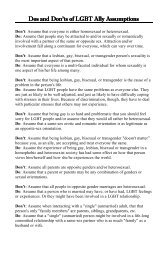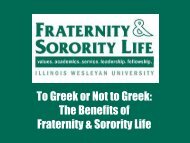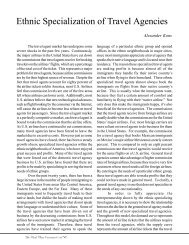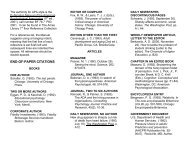in our 161st Year - Illinois Wesleyan University
in our 161st Year - Illinois Wesleyan University
in our 161st Year - Illinois Wesleyan University
You also want an ePaper? Increase the reach of your titles
YUMPU automatically turns print PDFs into web optimized ePapers that Google loves.
12 |<br />
Dave Barrett, M.S.<br />
Mel<strong>in</strong>da Baur, Ph.D.<br />
Brian Brennan, Ph.D.<br />
Craig Broadbent, Ph.D.<br />
Darryl Brown, Ph.D.<br />
William C. Brown, Ph.D.<br />
Carolyn Brown Kramer, Ph.D.<br />
Joshua Brown Kramer, Ph.D.<br />
Meghan Burke, Ph.D.<br />
Karen Bussone, M.B.A.<br />
John Ceballes, Ph.D.<br />
Mary Coleman, Ph.D.<br />
Amanda Coles, M.A.<br />
Mark Criley, Ph.D.<br />
Tammy Arv<strong>in</strong>, M.A.<br />
Jared Calaway, M.A.<br />
Jennifer Daniels, M.A.<br />
Like judicial robes, the garments worn on academic occasions such as today’s<br />
Commencement derive from the ecclesiastical garb of medieval England. The<br />
scholar <strong>in</strong> the Middles Ages, it must be remembered, was a clerk, and therefore<br />
required to wear the clerical gown and tonsure. Certa<strong>in</strong>ly, at Oxford and<br />
Cambridge, at least <strong>in</strong> the earliest times, the robes were monastic <strong>in</strong> orig<strong>in</strong>,<br />
although the hood was adapted from a lay garment common to both sexes and<br />
all classes.<br />
As early as the f<strong>our</strong>teenth Century, scholars of certa<strong>in</strong> colleges were required<br />
by statute to wear “a decent habit” befitt<strong>in</strong>g a clerk and no evidence appears that<br />
there was much differentiation among undergraduates, bachelor’s, master’s,<br />
and doctoral robes. All were black, commonly of lamb’s wool; most were furl<strong>in</strong>ed<br />
for warmth or at least fur trimmed; and the only mark of difference was<br />
<strong>in</strong> the fuller cut and ankle length of the master’s gown. The cope, or closed<br />
cape, was also black and followed the style of the everyday mantle of the clergy.<br />
Hoods were worn by all and probably had no academical significance at the<br />
beg<strong>in</strong>n<strong>in</strong>g. By 1330-40 doctors began to adopt scarlet for their hoods, and by<br />
1500, for their robes, with black reta<strong>in</strong>ed by the masters of arts and bachelors<br />
of div<strong>in</strong>ity. An act of Henry VIII <strong>in</strong> 1533 ratified the wear<strong>in</strong>g of robes of other<br />
colors. Hoods were l<strong>in</strong>ed with silk and m<strong>in</strong>iver fur, a custom surviv<strong>in</strong>g until<br />
the late seventeenth Century, but over the years dist<strong>in</strong>ctions were created to<br />
identify the various ranks and faculties.<br />
Caps evolved <strong>in</strong> similar manner. The round velvet cap is still worn today <strong>in</strong><br />
the full dress of doctors (except doctors <strong>in</strong> theology); the familiar square, or<br />
mortar-board, was copied <strong>in</strong> the early sixteenth Century from the thirteenth<br />
Century cap of the <strong>University</strong> of Paris. A third style also derives from Paris:<br />
a squared cap made by sew<strong>in</strong>g f<strong>our</strong> pieces of cloth with seams produc<strong>in</strong>g<br />
ridged edges, seen <strong>in</strong> modern times <strong>in</strong> the biretta of the clergy and the squared<br />
velvet cap of doctors of theology. The “who” and “how” of the wear<strong>in</strong>g of caps<br />
produced numerous rul<strong>in</strong>gs, restrictions, and change.<br />
The Reformation repressed the brilliant silks, gold lace, costly furs, and<br />
extravagant cut of academic robes, and the sober and more uniform styles are<br />
for the most part what we see today.<br />
However, the growth of higher education <strong>in</strong> the United States dur<strong>in</strong>g the<br />
n<strong>in</strong>eteenth Century, when the great land grant colleges and universities were<br />
established under the Morrill Act, created a confusion of conflict<strong>in</strong>g styles and<br />
colors. The easy identification of one’s academic status by means of cut, fabric,<br />
and color was no longer true.<br />
Assistant Professors<br />
Rose Danek, Ph.D.<br />
Saundra DeAthos-Meers, M.M.<br />
Bruno deHarak, Ph.D.<br />
Joanne Diaz, Ph.D.<br />
Robert Erlew<strong>in</strong>e, Ph.D.<br />
Eva Ferguson, M.M.<br />
Roger A. Garrett, M.M.<br />
Amit Ghosh, Ph.D.<br />
Alex Hughes, Ph.D.<br />
Tao J<strong>in</strong>, Ph.D.<br />
M<strong>in</strong> Hyoung Kim, Ph.D.<br />
Jo Y. Lacy, Ph.D.<br />
Edgar Lehr, Ph. D.<br />
Brenda Lessen, Ph.D.<br />
Alejandro Enriquez, M.A.<br />
Pennie Gray, M.S.<br />
Greogory Huffaker, B.A.<br />
Instructors<br />
Mark Liffiton, Ph.D.<br />
Robert R. Mangialardi, M.M.<br />
Meg P. M<strong>in</strong>er, M.S.<br />
Mignon Montpetit, Ph.D.<br />
Monica Moore, M.L.I.<br />
Marie Nebel-Schwalm, M.A.<br />
Vadoud Niri, Ph.D.<br />
Elisabeta Pana, Ph.D.<br />
Thushara Perera, Ph.D.<br />
Adriana Ponce, Ph.D.<br />
Matthew Pursell, Ph.D.<br />
Thomas Qu<strong>in</strong>n, M.F.A.<br />
Brian Russell, D.M.A.<br />
Lisabeth M. Sear<strong>in</strong>g, Ph.D.<br />
Kelly Changjun Huo, M.A.<br />
Noel Kerr, M.S.<br />
Jeanne Koehler, M.A.<br />
Academic Colors and Regalia<br />
Andrew Shallue, Ph.D.<br />
Brad E. Sheese, Ph.D.<br />
Jeungbo Shim, Ph.D.<br />
Dani Snyder-Young, Ph.D.<br />
Scott Susong, M.F.A.<br />
Susan L. Swanlund, Ph.D.<br />
Christopher Sweet, M.L.S.<br />
Jason Themanson, Ph.D.<br />
Sascha Vitzthum, Ph.D.<br />
Brian E. Walter, Ph.D.<br />
Aaron Zerhusen, Ph.D.<br />
Ryan Lak<strong>in</strong>, B.S.<br />
Leah Nillas, M.A.<br />
Amy Yeates, M.S.<br />
In 1893 an <strong>in</strong>tercollegiate commission presented a uniform code for caps,<br />
gowns, and hoods to be worn <strong>in</strong> the United States. The mortarboard caps are<br />
the same for doctoral, master’s, and baccalaureate degrees, except that doctors’<br />
caps may be of velvet and may have a gold tassel. The bachelor’s gown is marked<br />
by po<strong>in</strong>ted sleeves, reach<strong>in</strong>g to the knee, while the master’s sleeve is squared<br />
at the ends, and longer. The doctoral robe is fullest, with rounded bell shaped<br />
sleeves marked by three velvet stripes.<br />
The greatest symbolism of the academic costume is borne by the hood, which<br />
identifies the level of the degree, the faculty (or department of learn<strong>in</strong>g) <strong>in</strong><br />
which it was earned, and the <strong>in</strong>stitution which awarded it. The size of the hood,<br />
its shape, and the width of its velvet trim identify the level of the degree, with<br />
doctoral hoods naturally be<strong>in</strong>g the fullest, widest, and longest. Faculty colors<br />
tell us the department.<br />
Today’s graduates will be wear<strong>in</strong>g white for the College of Liberal Arts, p<strong>in</strong>k<br />
for the School of Music, apricot for the School of Nurs<strong>in</strong>g, golden yellow for the<br />
sciences, and brown for the f<strong>in</strong>e arts. Faculty members <strong>in</strong> the processional may<br />
be wear<strong>in</strong>g light blue for education, copper for economics, drab for bus<strong>in</strong>ess<br />
and accountancy, orange for eng<strong>in</strong>eer<strong>in</strong>g, purple for law, lemon for library<br />
science, green for medic<strong>in</strong>e, apricot for nurs<strong>in</strong>g, dark blue for philosophy, sage<br />
green for physical sciences, cream for social sciences, and scarlet for theology,<br />
among the many available. The colors are mandatory on hoods, but may also be<br />
used on the tassels and/or the velvet on doctoral gowns.<br />
The university or college is usually identified by the color of the hood l<strong>in</strong><strong>in</strong>g.<br />
Two colors are frequently used, s<strong>in</strong>ce there are approximately 2,000 degreegrant<strong>in</strong>g<br />
<strong>in</strong>stitutions <strong>in</strong> the United States. A few, such as Harvard, Yale,<br />
Pr<strong>in</strong>ceton, and the <strong>University</strong> of Chicago, use a s<strong>in</strong>gle color. Ill<strong>in</strong>ois <strong>Wesleyan</strong>’s<br />
green and white was adopted <strong>in</strong> 1888.<br />
The Ill<strong>in</strong>ois <strong>Wesleyan</strong> <strong>University</strong> Mace, first carried at the 1969 <strong>in</strong>auguration<br />
of Dr. Robert S. Eckley as fifteenth president of the <strong>University</strong>, is also a<br />
strik<strong>in</strong>g symbol of the <strong>in</strong>stitution. Made of bronze for power and endurance<br />
and of walnut for organic strength, its cupola represents the bell tower of Old<br />
North Hall, Ill<strong>in</strong>ois <strong>Wesleyan</strong>’s first build<strong>in</strong>g, which was erected <strong>in</strong> 1856 and<br />
demolished <strong>in</strong> 1966 to make way for Sheean Library. The bell suggests the<br />
Hedd<strong>in</strong>g Bell, a campus landmark s<strong>in</strong>ce 1931, when it was <strong>in</strong>stalled on the<br />
IWU campus after Hedd<strong>in</strong>g College was absorbed by the <strong>University</strong> dur<strong>in</strong>g<br />
the Great Depression. The staff of the Mace is made from the walnut of Old<br />
North Hall, and the names of Ill<strong>in</strong>ois <strong>Wesleyan</strong>’s presidents are engraved on<br />
its bronze base.

















